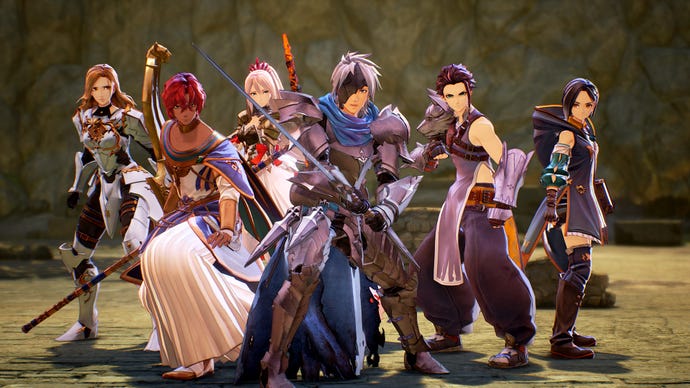Tales of Arise is one of the best JRPGs in years
Tales of Arise is confident, clever, deep, and more than a little bit beautiful. It’s a genre high point of recent years.
Over the weekend, I said something to a friend which sort of crystallized my thought process around Tales of Arise, the latest entry in the 26-year-old role-playing series from Namco. I said that if it were a Final Fantasy game, it’d probably have a sky-high critical reception and sell ten million copies.
The declaration was hyperbolic, but as is often the case there’s a razor-sharp kernel of truth at the center of it. Tales of Arise might not actually technically be the best in the series - it isn’t quite my favorite - but it’s certainly one of the best and most accessible Japanese RPGs in recent years - though the systems that make it newbie friendly also aren’t too heavy-handed, meaning there’s plenty here for old hands of the series to enjoy. Basically, it’s pitched just about perfectly.
In some ways, Arise feels reminiscent of games from the golden age of Japanese RPGs, by which I mean that era during the back end of the life of the Super NES and early on in the PlayStation’s life. I say this specifically because it happily deploys some of the same tropes that were common in that era but are considered a tad tired now, like an amnesic protagonist that gets swept into revolution. But it also reminds me of those games in other, more subtle ways, like how despite starring a bunch of archetypal anime pretty boys and girls, it has a surprising amount to say about serious issues. Much of the game is spent musing on topics like government oppression, slavery, and the cost of revolution. This reminds me of some of the golden age of the genre.
It’s perhaps because of these big themes that Arise embraces one particular difference in its narrative than other entries - it’s more focused on the bigger picture rather than the individuals. Because of this I found the cast perhaps a little under-developed compared to the series’ norm. Instead, the focus is on the machinations of the larger plot, which sees you tackling stories across five unique regions of the world, all of which are tied neatly together by the same overarching themes.
How do you successfully stoke the fires of revolution? Well, it happens to be in the same way that basically every JRPG progresses - through a series of escalating battles against monsters and evildoers. When you say ‘Japanese RPG’, people tend to think of classic turn-based games - but Tales of Arise was actually one of the first titles in the genre to really embrace action combat, and was experimenting with real-time action that was actually inspired by fighting games back when Final Fantasy was content with the variable speed but still turn-based Active Time Battle system.
.jpg?width=690&quality=70&format=jpg&auto=webp)
Arise still makes a number of smart changes to open the battles up and make them feel even more dynamic, mostly by giving the player more direct control over character movement. Lots of subtle changes and improvements add up to deliver what I’d say is the strongest Tales battle system in years, and one of the best action RPG battle systems out of Japan, up there with Final Fantasy 7 Remake.
You only control one character at a time, but you can swap around both your party members and controlled character on the fly as required. Other party members are controlled by AI, which can be adjusted by the player with a range of simple programming-style commands, where you can set up certain battle actions by your allies in response to specific battle conditions. There’s a hell of a lot of depth here, as there’s many party members and you roll around in a large group of six, meaning you can craft interesting party compositions that give you very specific abilities.
I’d actually say that managing your allies and building out a party that’ll do what you want, when you want is where some of the most satisfying meat of battle setup is. Although, to be fair, nothing is more satisfying than unleashing some of the game’s more cinematic special moves, known in this series as Artes, and watching them light up the screen and enemies. They look spectacular.
.jpg?width=690&quality=70&format=jpg&auto=webp)
The whole game does, in fact. As with the story, the visuals appear to be a little more focused on ‘the big picture’, but that’s no bad thing. The character models are fine - expressive and evocative of who these people are - but the star of the show is the world itself. Around every corner there’s a gorgeous new vista to appreciate, and in every battle you’ll be triggering artes that are as beautiful as they are destructive. The music, from Tales series composer Motoi Sakuraba (who also composed the Dark Souls games, by the way), is equally as beautiful.
Basically, I love it. It’s the best Tales game in a very long time, and the most-invested I’ve felt in a big-budget Japanese RPG in a very long time - except for Dragon Quest 11 and FF7 Remake, huge games that carry a lot of additional emotional baggage that surely aided in how I perceived them. Tales of Arise isn’t benefitting in the same way, as while I rather like Tales I'm nowhere near a series devotee - and it is, of course, completely disconnected from the rest of the series, as is tradition. Ultimately it’s just a bloody good game. People who love the genre should mark this down as must-play, but lapsed fans or those who have never really been into the genre could find this is the one that draws them in. It’s excellent.



